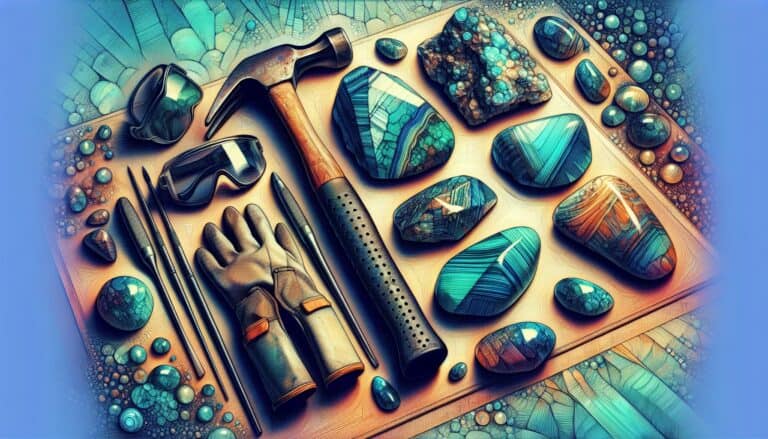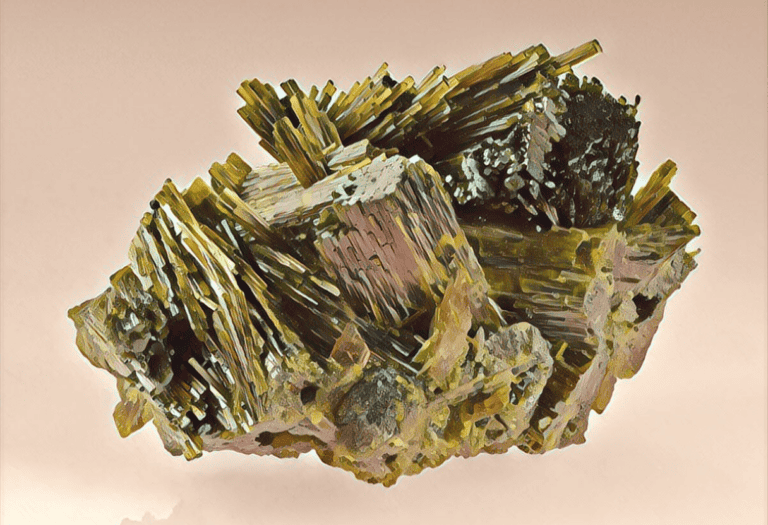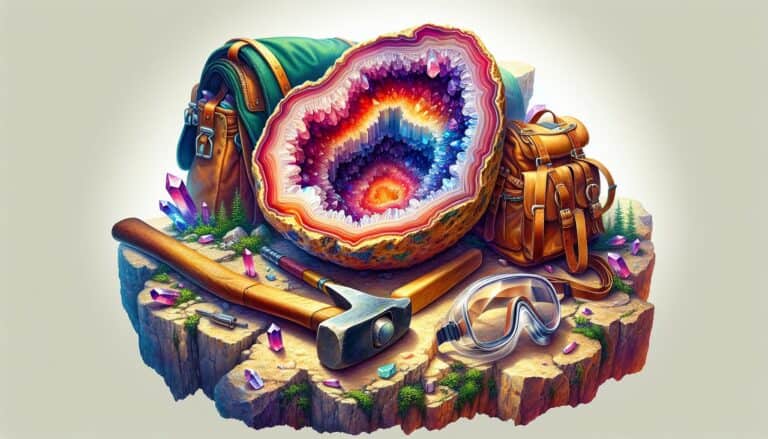Ever wondered about the value of that stunning aragonite piece you’ve seen?
I’m here to dive into what makes aragonite a gem in the mineral world and how its worth is determined. From its mesmerizing crystal forms to its diverse colors, aragonite’s uniqueness is undeniable.
Assessing aragonite’s value isn’t as straightforward as you might think. It’s not just about its beauty; various factors come into play. I’ll guide you through what influences aragonite’s market price, from rarity and size to color and quality.
Whether you’re a collector, a jewelry enthusiast, or just curious, understanding aragonite’s worth is essential. Stick with me as we explore the intricacies behind the valuation of this captivating mineral.
Aragonite’s value depends on rarity, color, size, and quality. Rare colors like vibrant blues and pinks are more valuable. Larger, clearer specimens command higher prices. It’s a carbonate mineral, found in various geological environments, and its value is also influenced by its crystal lattice structure and geographical origins.
What Is Aragonite
Aragonite is a carbonate mineral, one of the two common, naturally occurring crystal forms of calcium carbonate, CaCO3 (the other being calcite). It’s found in a variety of geological environments and is part of the make-up of many marine organisms’ shells and skeletons. I’ve always been fascinated by aragonite’s uniqueness, which is why I’m excited to share its wonders.
One remarkable aspect of aragonite is its crystal lattice structure, which differentiates it from calcite. Despite both minerals having the same chemical formula, their structures result in different physical properties. Aragonite forms orthorhombic crystals, and it’s this distinct structure that often results in the beautiful and varied crystal shapes that draw collectors.
Aragonite’s presence is widespread. It can be found in sedimentary rocks, as sinter in hot springs, and as a by-product in various industrial processes like the treatment of wastewater. And here’s an interesting bit: Most aragonite in the sedimentary rocks is believed to have been formed by biological processes.
There’s also the geographical spread to consider. Aragonite deposits are seen across the globe, from the United States and Mexico to Morocco and the Czech Republic. The location of an aragonite’s discovery can significantly influence its value. Aragonite from famous localities like Molina de Aragon in Spain often carries more value simply due to the historical connection to the mineral’s namesake.
In the context of its applications, aragonite is used in a surprising variety of ways. Its uses range from the foundation of native jewelry to providing crucial biological functions for marine life. As an added note, aragonite sands are heavily sought after in the aquarium industry, prized for their ability to maintain a healthy chemical balance in a marine tank.
The versatility of this mineral doesn’t stop with its practical applications. Its aesthetic appeal lies in the myriad of colors it exhibits. Aragonite can be transparent or opaque and can appear in hues from white and gray to shades of red, yellow, and green, each variation adding to its value and desirability.
Understanding Aragonite Value
When assessing the worth of aragonite, it’s imperative to comprehend the factors that impact its value. Rareness, quality, and color often dictate the market price for collectors and gem enthusiasts. Here’s what I’ve learned about evaluating aragonite:
Rarity and Provenance: The rarest forms of aragonite command the highest prices, particularly if they come from locations with historical significance. Specimens with well-documented provenance are always more sought after.
Quality and Size: Much like diamonds, aragonite value is influenced by the quality of the individual specimen. Clarity, size, and the intricacy of the crystal structure play crucial roles. Larger, more transparent pieces are typically of higher value. Here’s a breakdown:
| Quality Aspect | High Value Criteria |
|---|---|
| Clarity | High transparency, fewer inclusions |
| Size | Larger dimensions, substantial mass |
| Crystal Complexity | Intricate, well-formed structures |
Color: Aragonite presents a palette of colors, from clear, white, to vibrant blues and pinks. Generally, the more vibrant and uncommon the color, the more valuable the specimen.
Applications: Besides pure aesthetics, aragonite’s use in various industries also affects its price. For instance, high-grade aragonite is used in aquariums and jewelry, while lower quality is often utilized in agricultural and industrial applications, which can influence its value based on demand.
Market fluctuations and trends in the gemstone world also play a part in aragonite’s worth. As trends change, so does the popularity of certain minerals, impacting prices as a result. Moreover, since aragonite is sometimes confused with calcite, it’s essential to ensure authentication before any evaluation, as this can greatly affect the perceived value. It’s fascinating to see how these diverse factors intertwine to define the monetary worth of aragonite.
Factors Influencing Aragonite Worth
The worth of aragonite can significantly vary depending on several factors. I’m here to guide you through some of the key elements that come into play when determining the value of this versatile mineral.
Color and Transparency
When I think about the hordes of mineral enthusiasts and jewelry makers seeking aragonite, color and transparency are at the forefront of attributes that steer their demand. It’s undeniable that these two features play a pivotal role. Aragonite’s hues range from translucent neutrals to deep, vibrant tones. Rare colors like blues and pinks often fetch higher prices in the market.
Transparency adds another dimension to the worth of aragonite. More transparent pieces, which allow light to pass through and enhance the mineral’s innate glow, are sought-after over their opaque counterparts. For those who cherish natural artistry, the interplay between color and light through aragonite becomes a prized possession.
Size and Carat Weight
The physical size and the weight of aragonite in carats can also affect its value. Large specimens, particularly those that showcase aragonite’s dramatic crystal forms, can be exceedingly valuable. Typically, the mineral is found in smaller sizes, which makes larger pieces rarer and thus more expensive.
Jewelers and collectors often look for sizable pieces that make a statement. An impressive carat weight can significantly enhance the worth of an aragonite piece. This fact is especially true for those specimens that maintain exceptional color and clarity even in larger sizes.
Clarity and Luster
Lastly, let’s delve into clarity and luster, which are imperative for determining an aragonite’s appeal and worth. Clarity refers to the amount of inclusions or impurities within a stone. Aragonite with few to no inclusions is rare, and as you might guess, has a considerable price tag attached.
Luster is the way light interacts with the surface of a crystal. With aragonite, a high luster often denotes a specimen of superior quality, and consequently, a higher valuation. The way a piece of aragonite catches the light and reflects it back can turn an ordinary stone into a mesmerizing display.
Aragonite’s clarity and luster not only captivate the beholder but also ignite the urgency amongst collectors and enthusiasts to own a piece of this exquisite mineral. So, when you’re considering the worth of aragonite, remember that the clearer and more lustrous the specimen, the more valuable it is likely to be.
Aragonite Rarity and Origins
As we delve deeper into assessing aragonite’s value, it’s important to explore its origins and the rarity of quality specimens. Both of these elements play a significant role in the worth of aragonite on the market.
Geographical Sources of Aragonite
Let’s examine where aragonite comes from. This mineral, known for its stunning orthorhombic crystals, is not evenly scattered across the globe. Aragonite has geographical hubs where it is more commonly found. These locations include the Bahama Islands, where vast beds of aragonite sand can be found due to biological processes. Italy, specifically the Aragon River—a name from which aragonite gets its name—also hosts this calcium carbonate mineral.
Other notable locations harboring aragonite deposits include:
- Mexico, famed for its vibrant blue specimens
- Morocco, with an abundance of red and brown aragonite
- United States, particularly in the state of Arizona
Each geological source gives aragonite distinct characteristics. For instance, aragonite from Italy often displays a classic translucence, whereas Bahamian aragonite sands are renowned for their purity and uniform grain size. It’s the unique attributes from each of these regions that can amplify aragonite’s value.
The Rarity of Quality Specimens
Quality specimens of aragonite are a collector’s delight but are not always easy to come by. When we talk about rarity in the context of aragonite, we’re focusing on pieces that coincide with the desirable features previously mentioned: color, transparency, clarity, and size. Such specimens often come from localized pockets within aragonite-rich regions, making them all the more sought after.
Rarity can thus be boiled down to the following factors:
- The prevalence of the ideal color spectrum in a given batch of aragonite
- The frequency of finding pieces with exceptional transparency and clarity
- The discovery rate of large, undamaged crystals with significant carat weights
With rarity intrinsic to its allure, aragonite pieces that score high in these categories don’t just catch the eye—they also command higher prices on the market. It’s undeniable that when one uncovers an aragonite specimen that’s both visually striking and rare, it’s like finding a hidden gem in the rocky realms of mineralogy.
Pricing Trends for Aragonite
Market Demand for Aragonite
In the competitive realm of mineral collections, the market demand for aragonite significantly influences its price. Enthusiasts and collectors often seek out unique pieces, with the appetite for distinct aragonite variations growing year over year. This trend reflects in the upward swing of aragonite prices, especially for specimens that showcase rare colors or remarkable crystal formations.
Specialty mineral shows and online marketplaces have amplified aragonite’s visibility, leading to an increase in both casual interest and educated demand. The demand peaks for aragonite stones that exhibit iridescent qualities or noteworthy provenance.
Interestingly, industrial demand also plays a part. Aragonite’s role in environmental products, such as soil sweeteners, further drives its market value. However, it’s in the realm of jewelry and ornamentation where demand has had the most significant impact on pricing. Exceptional pieces often garner impressive bids at auctions, setting benchmarks for future sales.
Comparative Values with Other Gemstones
When compared to other gemstones, aragonite’s worth is a versatile subject. While not as universally renowned as diamonds or sapphires, aragonite holds its own niche in the market. Quality and rarity are potent determiners when setting aragonite’s worth in relation to other minerals and gemstones. A direct comparison is challenging due to this variability, but certain aragonite specimens can rival the cost of well-known gemstones on a per-carat basis.
Here’s a quick look at aragonite’s value in comparison to other gemstones:
| Gemstone | Average Price per Carat |
|---|---|
| Aragonite | $5 – $100 |
| Sapphire | $25 – $1,200 |
| Diamond | $2,500 – $20,000 |
These figures showcase the wide pricing spectrum for various gemstones, placing aragonite at an accessible yet potentially pricey position, depending on its qualities. The allure of aragonite is also bolstered by its uniqueness; many customers find value in owning a piece that stands out from more common gemstones.
The market for aragonite responds well to stones that present exceptional features. Factors such as color intensity, size, and clarity can make certain aragonite samples more valuable than some semi-precious stones. As trends evolve and new applications for aragonite are discovered, its comparative standing among other gemstones could shift, highlighting the dynamic nature of the gem market.
The Most Expensive Aragonite
When we dive into the realm of the most expensive aragonite specimens, stunning visuals and exclusive characteristics often dictate the steep price tag. I’ve gathered information showing that the crème de la crème of aragonite can fetch prices ranging from several hundred to thousands of dollars per piece. Factors leading to these high-value sales include:
- Exceptional color variations
- Awe-inspiring crystal formations
- Remarkable size and scale
- Superior clarity and translucence
It’s not just aesthetics that elevate the price. Geological rarity plays a crucial role. Aragonite formations with unusual bifurcations or those found in unique geographic locations can see their worth skyrocket, establishing them as centerpieces of high-end mineral collections. Collectors and enthusiasts often battle it out at auctions for ownership of these extraordinary specimens.
The diversity in aragonite’s appearance also impacts its valuation. Pieces that display a captivating array of colors like blue, green, or the elusive purple hue can command a premium, especially if the pigmentation is vivid and evenly distributed. The Sputnik Aragonite, with its starburst-like appearance, has been known to garner hefty sums due to its fascinating natural artistry.
To illustrate the value scope, here’s a snapshot of the most expensive aragonite pieces sold in recent years:
| Description | Size | Price |
|---|---|---|
| Vivid Blue Aragonite | 2 inches | $1,500 |
| Green Aragonite Star | 3 inches | $2,000 |
| Rare Purple Aragonite | 1.5 inches | $3,000 |
These figures are testament to the fact that while all aragonite has inherent charm, there’s a remarkable leap in worth when we consider pieces that are natural works of art. Collectors continue to be willing to invest heavily in aragonite that not only enriches their collections aesthetically but also offers the excitement that comes with possessing a piece of Earth’s rare beauty.
How to Appraise Aragonite
Expert Evaluation Techniques
When I delve into the process of appraising aragonite, specifics such as the stone’s color, clarity, and carat weight take center stage. Gemologists rely on sophisticated tools and their trained eyes to assess these attributes. I use a jeweler’s loupe, a small magnification device, to closely examine the surface and internal features of the aragonite. The clearer and more colorful the specimen, the more valuable it tends to be.
Certain spectroscopy methods can analyze the mineral composition and verify authenticity, ensuring the aragonite isn’t an imitation or misidentified. Infrared spectroscopy in particular is common, as it’s a non-destructive method that provides a clear signature of the mineral’s makeup. Size also matters; larger aragonite pieces, especially those that have maintained their natural crystal formation, are evaluated at higher rates.
For those specimens with astounding luster and iridescence, I often find they have a unique play of light that enhances their worth significantly. It’s more than just a visual evaluation as the luster is quantifiable under specific lighting conditions. Reflective properties are measured, and the results contribute to the overall profiling of the mineral.
Certification and Appraisal Resources
When looking for resources to certify and appraise aragonite, I suggest starting with reputable gemological laboratories. These facilities provide authoritative certifications that document the quality and characteristics of gemstones. They’re essential for anyone looking to ensure the provenance and value of their aragonite. Laboratories like the Gemological Institute of America (GIA) offer thorough services that are recognized worldwide.
Another reliable resource is professional appraisal associations. Membership with organizations such as the American Society of Appraisers ensures that an individual has the required training and adheres to ethical standards. Here’s a handy list of go-to options for those seeking to appraise their aragonite:
- Gemological Institute of America (GIA)
- International Gemological Institute (IGI)
- American Gem Society (AGS)
These resources have online databases and locator services to find certified appraisers near you which isn’t just convenient; it’s essential for accuracy and maintaining confidence in the appraisal process. Remember, documentation from these organizations serves as a powerful tool whether you’re insuring your aragonite, considering a sale, or simply cataloging your collection. It’s a step I never skip, as it adds an additional layer of credibility to the stone’s assessed value.
Tips for Buying and Selling Aragonite
Where to Buy Aragonite
When you’re looking to purchase aragonite, authenticity and quality are paramount. I usually start by visiting reputable mineral and gemstone dealers who have a well-established presence either online or in a storefront. These sellers often have direct connections to the mines and have better access to high-quality specimens. Specialty gem and mineral shows are also prime spots to find aragonite. Here, you can see the stones in person and assess their luster and clarity up close.
Online marketplaces are another option but require a bit more caution. Look for sellers with high ratings and positive feedback from previous buyers. Always request detailed photographs and information about the stone, such as its origin and any treatments it may have undergone.
Before making a purchase, whether in-person or online, make sure to check the return policy and guarantee of authenticity. You don’t want to be stuck with a piece that doesn’t meet your expectations or, worse, isn’t genuine aragonite.
How to Sell Aragonite Safely
When it comes time to sell your aragonite, protecting your investment is crucial. The first step is to gather all documentation related to the piece, including any certificates of authenticity, appraisal reports, and origin stories tied to the piece. This paperwork is essential in establishing the value and legitimacy of your aragonite, thus commanding a better price.
One safe avenue for selling aragonite is through professional auctions, both physical and online, specializing in minerals and gemstones. These platforms attract serious collectors who understand the value of aragonite and are willing to pay market price or higher for exceptional pieces.
If you opt to sell directly to individual buyers via online marketplaces, ensure you have secure payment methods in place. Consider using escrow services for high-value transactions to protect both you and the buyer. Be clear and honest in your product descriptions, and be ready to provide detailed images and information to potential buyers.
For personal safety and the avoidance of scams, always meet in public places if handling the transaction in person. If the piece is exceptionally valuable, conducting the sale at a bank or with a professional broker present can provide additional security and peace of mind.
Transparency, detailed descriptions, and safe transaction practices are key to successfully navigating the world of buying and selling aragonite stones.
Conclusion: Buying & Selling Aragonite
Determining aragonite’s worth is a nuanced process that hinges on various factors. I’ve shared how its value is influenced by its physical attributes and rarity, with exceptional pieces fetching premium prices. I’ve also provided practical advice on buying and selling this captivating mineral.
Remember, when you’re in the market for aragonite, choose reputable sources and be vigilant about transaction details. If you’re selling, ensure your piece is well-documented and consider the most secure avenues for the sale. Aragonite’s beauty is undeniable, and with the right knowledge, you can navigate its market confidently.
Whether adding to your collection or looking to sell, understanding the intricacies of aragonite’s value is key to making informed decisions.



![Alaska Rockhounding Sites in [year]: Locations & Gems](https://observationhobbies.com/wp-content/uploads/2024/01/w8vGE4zrwO-0XFwKV2tuI-768x439.jpg)



